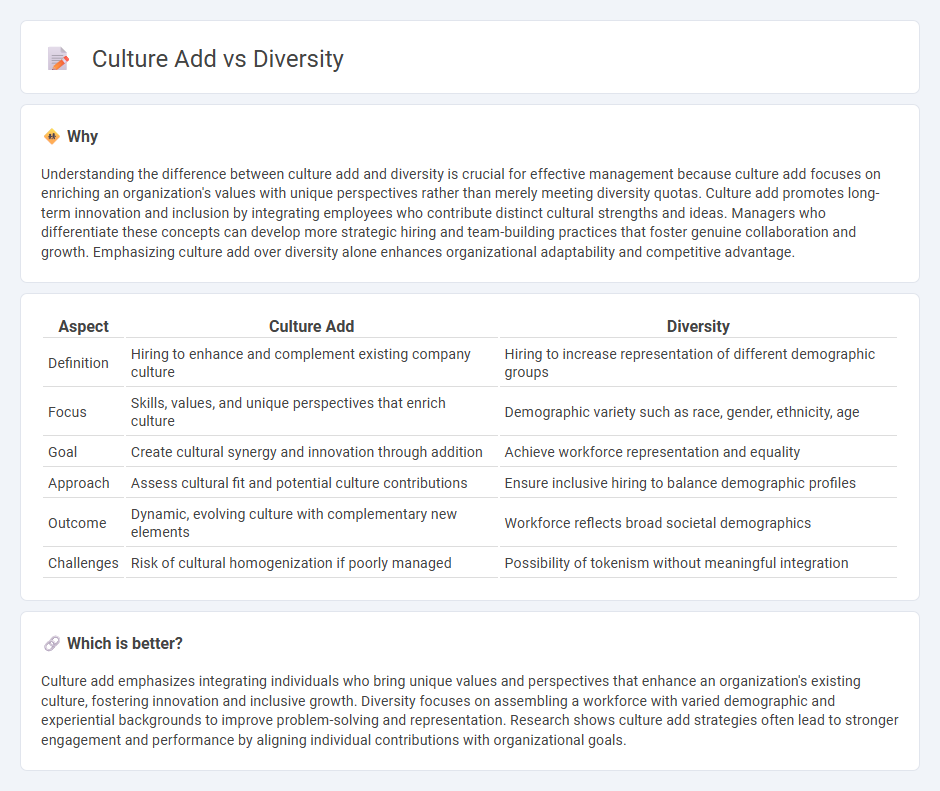
Management strategies that prioritize organizational culture focus on shared values, beliefs, and behaviors that shape employee engagement and cohesion. Emphasizing diversity involves recognizing and leveraging differences in backgrounds, perspectives, and experiences to drive innovation and competitive advantage. Explore more about how effectively balancing culture and diversity can transform management practices.
Why it is important
Understanding the difference between culture add and diversity is crucial for effective management because culture add focuses on enriching an organization's values with unique perspectives rather than merely meeting diversity quotas. Culture add promotes long-term innovation and inclusion by integrating employees who contribute distinct cultural strengths and ideas. Managers who differentiate these concepts can develop more strategic hiring and team-building practices that foster genuine collaboration and growth. Emphasizing culture add over diversity alone enhances organizational adaptability and competitive advantage.
Comparison Table
| Aspect | Culture Add | Diversity |
|---|---|---|
| Definition | Hiring to enhance and complement existing company culture | Hiring to increase representation of different demographic groups |
| Focus | Skills, values, and unique perspectives that enrich culture | Demographic variety such as race, gender, ethnicity, age |
| Goal | Create cultural synergy and innovation through addition | Achieve workforce representation and equality |
| Approach | Assess cultural fit and potential culture contributions | Ensure inclusive hiring to balance demographic profiles |
| Outcome | Dynamic, evolving culture with complementary new elements | Workforce reflects broad societal demographics |
| Challenges | Risk of cultural homogenization if poorly managed | Possibility of tokenism without meaningful integration |
Which is better?
Culture add emphasizes integrating individuals who bring unique values and perspectives that enhance an organization's existing culture, fostering innovation and inclusive growth. Diversity focuses on assembling a workforce with varied demographic and experiential backgrounds to improve problem-solving and representation. Research shows culture add strategies often lead to stronger engagement and performance by aligning individual contributions with organizational goals.
Connection
Organizational culture shapes values, beliefs, and behaviors that influence how diversity is perceived and integrated within a company. A strong culture promoting inclusivity fosters diverse perspectives, driving innovation and improving decision-making. Embracing diversity within culture enhances employee engagement, collaboration, and overall management effectiveness.
Key Terms
Inclusion
Diversity encompasses the variety of individual differences such as race, gender, age, and ethnicity within a group, while culture refers to the shared values, beliefs, and behaviors that shape social identity. Inclusion emphasizes creating an environment where diverse individuals feel valued, respected, and empowered to contribute fully. Explore how integrating diversity, culture, and inclusion strategies can transform organizational success and employee engagement.
Cultural Competence
Diversity encompasses the presence of differences such as race, ethnicity, gender, and age within a group, while culture refers to the shared values, beliefs, practices, and traditions that define a community. Cultural competence involves understanding, respecting, and effectively interacting with individuals from diverse cultural backgrounds to improve communication and collaboration. Explore how developing cultural competence enhances workplace inclusion and drives organizational success.
Equity
Diversity encompasses the presence of varied identities and backgrounds within a group, while culture reflects the shared values, traditions, and behaviors that define that group. Equity focuses on ensuring fair treatment, access, and opportunities for all individuals, addressing systemic inequalities that impact both diversity and culture. Explore how integrating equity strengthens organizational dynamics by fostering an inclusive environment that values both diversity and culture.
Source and External Links
What is diversity? - This article discusses diversity as a practice of including people from various social and ethnic backgrounds, enhancing workplaces through diverse perspectives and talent.
Diversity (business) - Diversity in business refers to the practice of hiring and promoting employees from diverse backgrounds, contributing to organizational innovation and performance.
What is Diversity & Inclusion? - This webpage explores diversity as appreciating and respecting differences among individuals, fostering a positive and inclusive environment.
 dowidth.com
dowidth.com